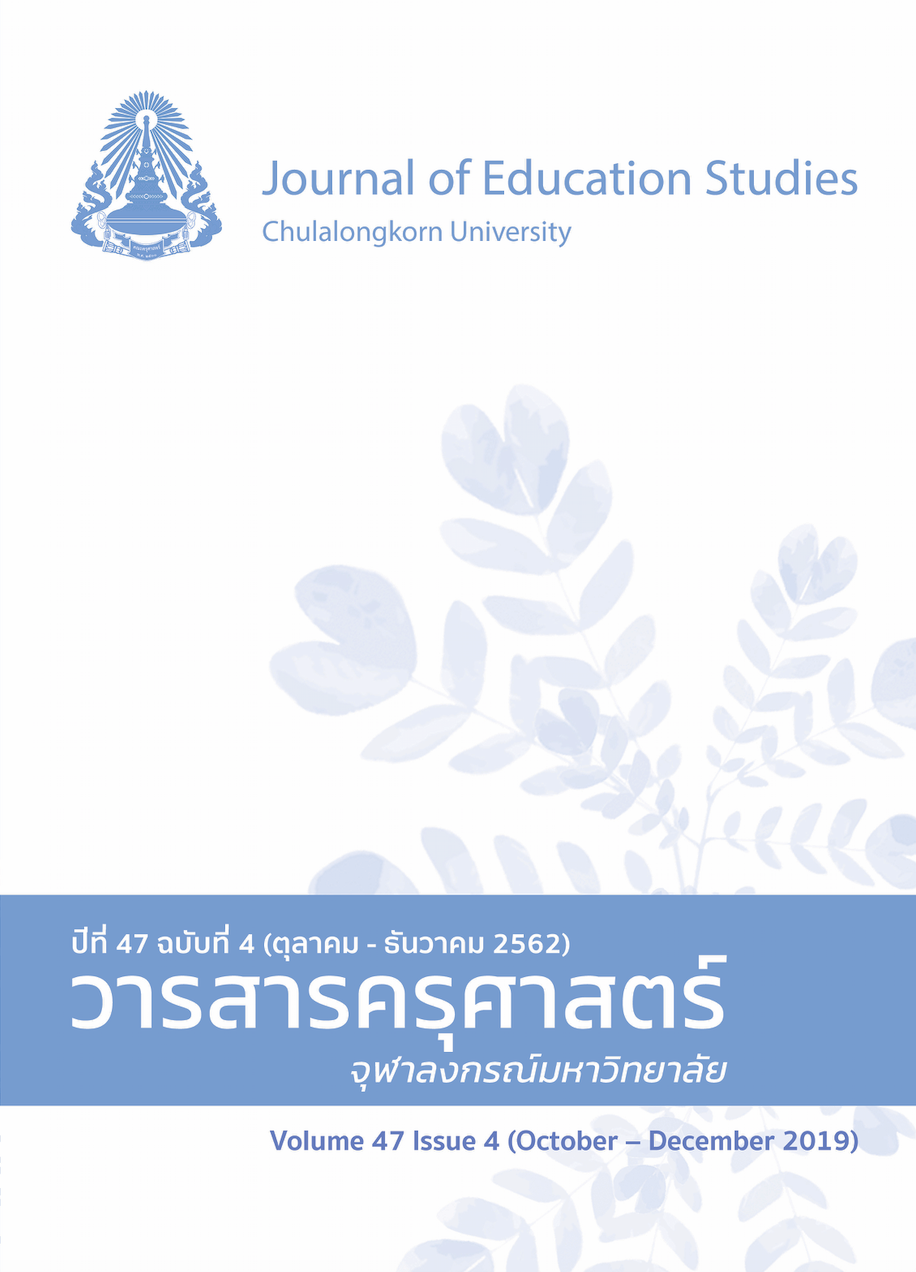Misconceptions and Mistakes in Mathematics on Inequality of Ninth Grade Students
Keywords:
MISCONCEPTION, MISTAKE, INEQUALITYAbstract
The objectives of this research were 1) to study misconceptions and mistakes in mathematics in relation to inequalities, and 2) to find the cause of mathematical misconceptions on inequalities. The target group was a group of 45 students who were studying in ninth grade at a school in Phitsanulok Province. Research instruments included tests of misconceptions and mistakes in mathematics regarding inequalities and a structured interview form. Data were analyzed by finding the frequencies and analyzing the content.
The results showed that: 1) there are two forms of misconceptions and mistakes: misconceptions and mistakes of language and misconceptions and mistakes of theories, rules, formulas, definitions and properties; and 2) the causes of misconceptions include misconstruction of terminology on inequalities, misunderstanding in a sentence, misunderstanding of addition properties of inequalities, misunderstanding of multiplication property of inequalities and having weak numeracy skills.
References
กระทรวงศึกษาธิการ. (2560). มาตรฐานการเรียนรู้และตัวชี้วัด กลุ่มสาระการเรียนรู้คณิตศาสตร์ วิทยาศาสตร์ และสาระภูมิศาสตร์ในกลุ่มสาระการเรียนรู้สังคมศึกษา ศาสนา และวัฒนธรรม (ฉบับปรับปรุง พ.ศ. 2560) ตามหลักสูตรแกนกลางการศึกษาขั้นพื้นฐาน พุทธศักราช 2551. กรุงเทพฯ: ชุมนุมสหกรณ์การเกษตรแห่งประเทศไทย.
ชานนท์ จันทรา. (2553). ขั้นตอนวิธีการพิสูจน์ทางคณิตศาสตร์สำหรับครู. กรุงเทพฯ: อาร์ แอนด์ เอ็น ปริ้นท์.
ทองคำ นาสมตรึก, สมทรง สุวพาณิช, และ อรุณี จันทร์ศิลา. (2555). การวิเคราะห์มโนทัศน์ที่คลาดเคลื่อนทางการเรียนคณิตศาสตร์ เรื่องสมการเชิงเส้นตัวแปรเดียว ของนักเรียนชั้นมัธยมศึกษาปีที่ 1. วารสารวิชาการมหาวิทยาลัยราชภัฏบุรีรัมย์, 4(1), 75-88.
วิชัย ดิสสระ. (2535). การพัฒนาหลักสูตรและการสอน. กรุงเทพฯ: สุวีริยาสาส์น.
สถาบันส่งเสริมการสอนวิทยาศาสตร์และเทคโนโลยี. (2554). ทักษะ/กระบวนการทางคณิตศาสตร์. กรุงเทพฯ: คุรุสภาลาดพร้าว.
สถาบันทดสอบทางการศึกษาแห่งชาติ. (2562). สถิติ O-NET ย้อนหลัง. สืบค้นจาก http://www.niets.or.th/th/catalog/view/3865
สิริพร ทิพย์คง. (2545). หลักสูตรและการสอนคณิตศาสตร์. กรุงเทพฯ: พัฒนาคุณภาพวิชาการ.
สุกัญญา สีสมบา. (2554). การวิเคราะห์มโนทัศน์ที่คลาดเคลื่อนและข้อผิดพลาดทางคณิตศาสตร์ เรื่อง อสมการ ของนักเรียนชั้นมัธยมศึกษาปีที่ 3 โรงเรียนศรีสมเด็จพิมพ์พัฒนาวิทยา อำเภอศรีสมเด็จ จังหวัดร้อยเอ็ด (วิทยานิพนธ์ปริญญามหาบัณฑิต ไม่ได้ตีพิมพ์). มหาวิทยาลัยราชภัฏมหาสารคาม, มหาสารคาม.
สุรัตนา สังข์หนุน, ชนศักดิ์ บ่ายเที่ยง, และ สุพร รัตนพันธ์. (2554). การพัฒนาโปรแกรมวิเคราะห์ข้อสอบอัตนัย. วารสารวิชาการพระจอมเกล้าพระนครเหนือ, 21(3), 627-635.
อัมพร ม้าคนอง. (2536). การวินิจฉัยข้อผิดพลาดทางการเรียนคณิตศาสตร์ของนักเรียนชั้นมัธยมศึกษาปีที่ 5 โรงเรียนสาธิตจุฬาลงกรณ์มหาวิทยาลัย (รายงานการวิจัย). กรุงเทพฯ. คณะครุศาสตร์ จุฬาลงกรณ์มหาวิทยาลัย.
อัมพร ม้าคนอง. (2551). การพัฒนามโนทัศน์ทางคณิตศาสตร์โดยใช้โมเดลการได้มาซึ่งมโนทัศน์ และคำถามระดับสูง (รายงานการวิจัย). กรุงเทพฯ. คณะครุศาสตร์ จุฬาลงกรณ์มหาวิทยาลัย.
อัมพร ม้าคนอง. (2554). ทักษะและกระบวนการทางคณิตศาสตร์. กรุงเทพฯ: โรงพิมพ์แห่งจุฬาลงกรณ์มหาวิทยาลัย.
อัมพร ม้าคนอง. (2557). คณิตศาสตร์สำหรับครูระดับมัธยมศึกษา. กรุงเทพฯ: โรงพิมพ์แห่งจุฬาลงกรณ์มหาวิทยาลัย.
ภาษาอังกฤษ
Allen, D. G. (2007). Student thinking. Retrieved from http://mtc.tamu.edu/9-12/index_9-12.htm?9-12M2L1.htm
Chai, C. M., & Ang, B. H. (1987). Identifying the reasons underlying pupil’s particular errors in simple algebraic expression and equations. Proceedings of Fourth Southeast Asian Conference on Mathematical Education (ICMI–SEAMS) (1-3), 189–198.
Cornbach, L. J. (1951). Coefficient alpha and the internal structure of tests. Psychometrika, 16(3), 297-334.
Graeber, A. (1992, April). Recognizing and changing middle school students' mathematical misconceptions. Paper presented at the 70th annual meeting of the National Council of Teachers of Mathematics. Nashville, TN.
Hopkins, C. D., & Antes, R. L. (1990). Classroom measurement and evaluation (3rd ed.). Itasca, IL: F. E. Peacock.
Movshovitz-Hader, N., Zaslavsky, O., & Inbar, S. (1987). An empirical classification model for errors in high school mathematics. Journal for Research in Mathematics Education, 18(1), 3-14.
Radatz, H. (1979). Error analysis in mathematics education. Journal for Research in Mathematics Education, 10(3), 163-172.
Riccomini, P. J. (2005). Identification and remediation of systematic error patterns in subtraction. Learning Disability Quarterly, 28(3), 233–242.
Rovinelli, R. J., & Hambleton, R. K. (1977). On the use of content specialists in the assessment of criterion-referenced test item validity. Dutch Journal of Educational Research, 2(2), 49-60.




